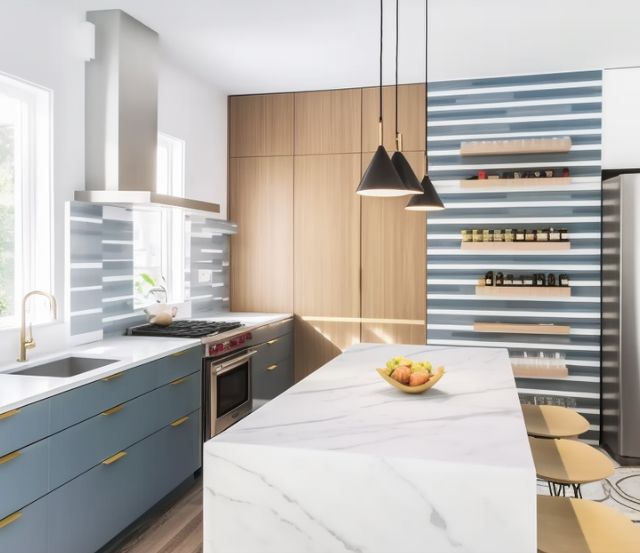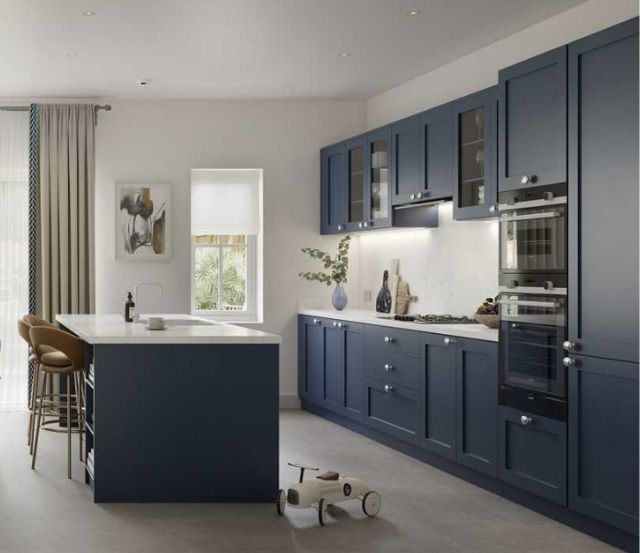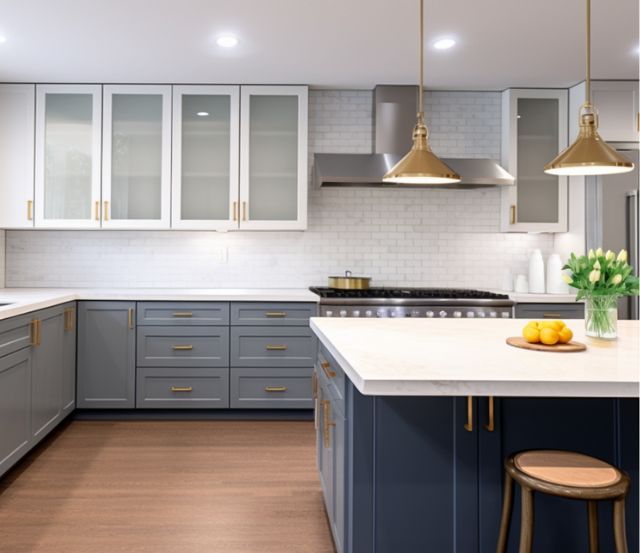Cabinet Style 101: Contemporary, Traditional, Modern & Transitional
Cabinets are not just functional storage solutions; they also play a vital role in defining the style and ambiance of a room. In this blog post, we’ll introduce and explore four popular cabinet styles: Contemporary, modern, traditional, and transitional.
The differences between contemporary, modern, classic, and transitional cabinet styles primarily relate to their aesthetics, materials, and design principles. We’ll breakdown each style below.
In case you are a hands on learner…


Contemporary Cabinet Style
- Contemporary cabinets are characterized by their sleek, clean lines and minimalistic design.
- They often feature flat or slab-front doors without elaborate ornamentation or decorative details.
- Materials commonly used for contemporary cabinets include wood with a natural finish, glass, metal, and sometimes even plastic or composite materials.
- Colors in contemporary cabinets tend to be neutral and monochromatic, with an emphasis on blacks, whites, grays, and muted tones.
- Hardware, such as handles and knobs, is usually understated and may even be absent, with cabinets featuring push-to-open or touch-latch mechanisms.
- Contemporary cabinets aim to create a sense of simplicity, functionality, and a clean, uncluttered look.
Modern Cabinet Style
- Modern cabinets share some similarities with contemporary cabinets but have a broader historical reference point.
- They often incorporate a mix of natural and synthetic materials, such as wood, metal, glass, and plastic.
- Modern cabinets may feature more geometric shapes and patterns, and they can incorporate some mid-century or industrial design elements.
- Colors used in modern cabinets can vary, but they often include a combination of neutral tones with bolder accents.
- Hardware is typically minimalistic and may include simple, geometric handles or knobs.
- Modern cabinets aim to achieve a balance between form and function, incorporating innovative design concepts while maintaining usability.


Traditional & Transitional Cabinet Styles
- Both styles are elegant and timeless. They celebrate the classic characteristics of traditional design, but the transitional will take the ornate details and tone them down for a more modern effect. The transitional style elements will allow you to add modern touches, like lighting fixtures and hardware.
- Traditional cabinetry aims to create spaces that resonate with timeless beauty, harkening back to design periods like the Victorian era, Colonial America, or the rustic charm of French country. It’s a style that appeals to those who appreciate the enduring appeal of classic aesthetics and the warmth they bring to a home.
- Transitional cabinets aim to create spaces that feel both classic and up-to-date, offering a sense of comfort and flexibility that appeals to a wide range of homeowners.
Transitional Cabinet Styles
- Transitional cabinets offer a unique blend of traditional and contemporary design elements, resulting in a versatile and adaptable cabinet style.
- They often incorporate door styles that strike a balance between classic and modern aesthetics, creating a harmonious look that suits a variety of preferences.
- Transitional cabinet doors may combine raised panel designs reminiscent of classic cabinets with clean, flat-front or shaker-style doors characteristic of contemporary cabinets.
- The color palette for transitional cabinets leans towards neutral tones, allowing for a timeless appeal while providing flexibility to complement different interior design themes.
- Hardware used in transitional cabinets is typically understated and simple, striking a balance between the ornate hardware found in classic cabinets and the minimalistic hardware of contemporary cabinets.
- Transitional cabinets aim to create spaces that feel both classic and up-to-date, offering a sense of comfort and flexibility that appeals to a wide range of homeowners.
- Transitional cabinetry often incorporates door styles that strike a balance between classic and modern aesthetics, creating a harmonious look that suits a variety of preferences.
- In terms of hardware, traditional cabinetry tends to feature ornate and vintage-inspired handles, knobs, and hinges. These fine details contribute to the overall elegance and historical allure.
- Transitional cabinet doors may combine raised panel designs reminiscent of classic cabinets with clean, flat-front or shaker-style doors characteristic of contemporary cabinets.
- Traditional cabinetry aims to create spaces that resonate with timeless beauty, harkening back to design periods like the Victorian era, Colonial America, or the rustic charm of French country. It’s a style that appeals to those who appreciate the enduring appeal of classic aesthetics and the warmth they bring to a home.
- Transitional cabinets aim to create spaces that feel both classic and up-to-date, offering a sense of comfort and flexibility that appeals to a wide range of homeowners.

Putting It All Together
Your choice of cabinet style can significantly impact the overall look and feel of your kitchen or living space. Whether you prefer the sleek and minimalistic appeal of contemporary and modern cabinet styles or the timeless elegance of traditional cabinets, or you’re looking for the adaptability of transitional cabinets, understanding the designs associated with each style is a crucial first step. By selecting the right cabinet style, you can create a space that aligns with your taste and complements your unique lifestyle.
Now that you know the basics, you’ll be able to impress our Cabinet Designers with your knowledge when you stop by a showroom, or connect with us online. Even if you’re just getting ideas about your remodel, we’re here to help you select the perfect style for your kitchen, closet, or bathroom. Get in touch today to get started designing your dream space.